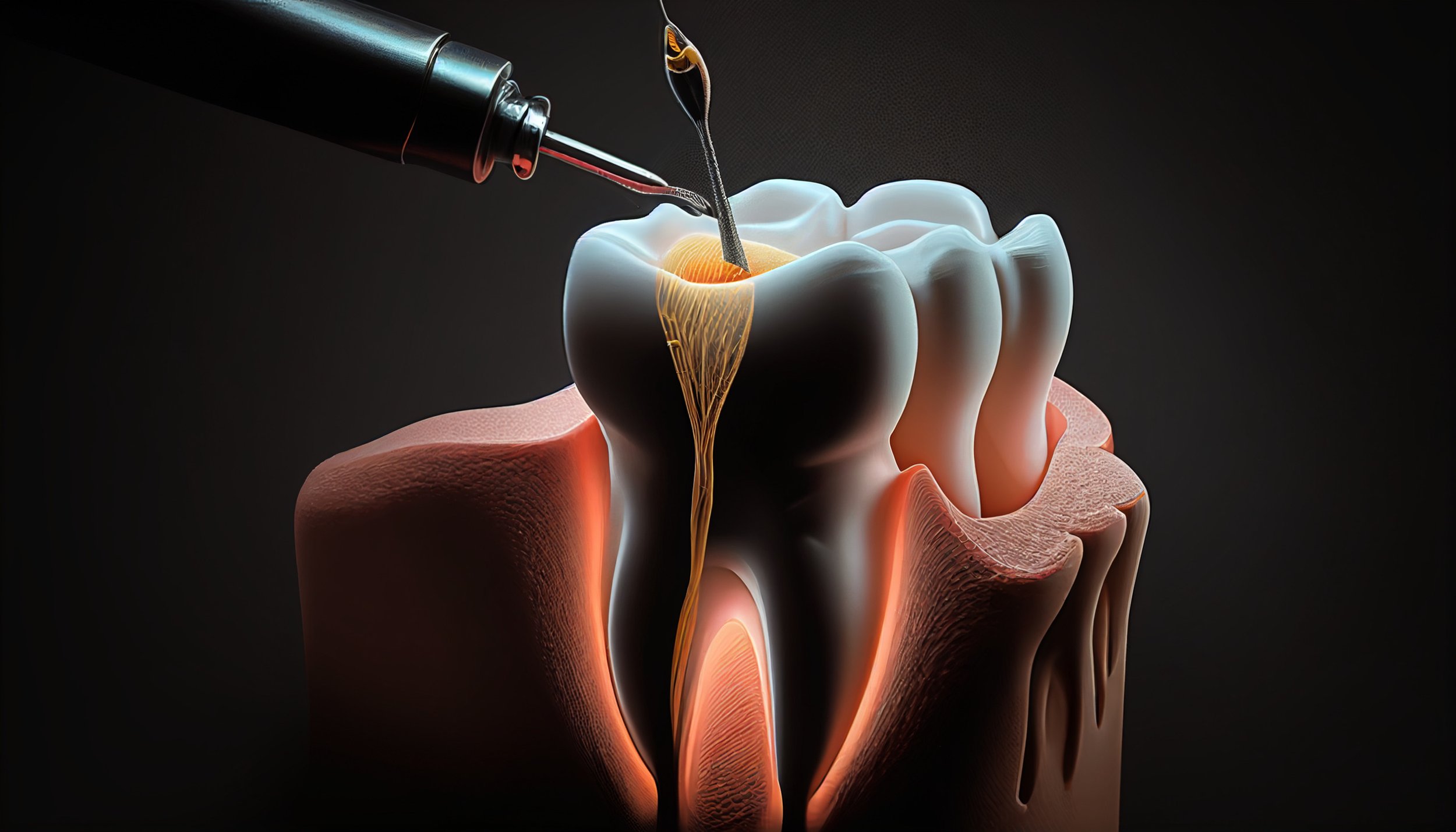Root Canal Treatment (RCT)
Root Canal Treatment in Singapore
Are you facing a tooth infection or damaged pulp from decay or trauma? Consider getting professional root canal treatment (RCT), also known as endodontic treatment, at our dental clinic today.
Root Canal Treatment is a standard dental care option that many patients in Singapore undergo. It is typically performed as a last effort to save the natural tooth, helping to relieve discomfort and maintain dental function when other interventions have not sufficed.
Understanding Root Canal Treatment
Root Canal Treatment, or RCT, addresses severe tooth infections or decay by removing the tooth's pulp—the inner tissue containing nerves and blood vessels. The tooth is then cleaned, disinfected, and filled to seal it. This endodontic treatment helps prevent the spread of infection to other teeth while maintaining the tooth's structural integrity and functionality, thereby avoiding extraction. It focuses on relieving discomfort and restoring dental health and strength.
Why Do You Need Root Canal Treatment?
Root Canal Treatment is necessitated primarily by conditions that compromise the health of the tooth’s pulp. These include deep decays or cavities that expose the pulp to bacteria, leading to infection; physical trauma that damages the pulp even without visible signs of injury; and cracks or chips in the tooth that provide a pathway for bacteria to infiltrate and infect the pulp.
Additionally, severe gum disease can extend into the pulp, necessitating intervention. These issues, if left untreated, can result in severe pain and inflammation, making RCT treatment a viable option to help alleviate symptoms and prevent tooth loss.
Types of Root Canal Treatment
Review the different types of root canal treatments and assess which one fits your dental needs.
Anterior Root Canal
An anterior root canal targets the front teeth, which typically have a single root and a simpler canal structure. This makes the intervention less complex than treating molars, often resulting in a more straightforward treatment approach.
Premolar Root Canal
Premolars often have one or two roots with one or two canals, sometimes more curved than other teeth, making the treatment more complex than for anterior teeth. Root canal treatment in premolars focuses on thoroughly cleaning and shaping the canals to prevent future infection and maintain proper chewing function.
Molar Root Canal
A molar root canal treatment is the most complex for RCT treatment due to their larger size and multiple roots, often containing three or more canals. These teeth require meticulous care to ensure all canals are properly cleaned and sealed in order to address endodontic infections and restore the tooth for long-term functionality.
Cost of Root Canal Treatment (RCT) in Singapore
Anterior Tooth Prices
Root canal treatment or RCT for an anterior tooth costs an average of S$436 to S$545 .
Premolar Tooth Prices
Root canal treatment or RCT for a premolar tooth costs an average of $654 to $763
Molar Tooth Prices
Root canal treatment or RCT for a molar tooth costs an average of S$872 to S$981.
Benefits of Root Canal Treatment
Let’s take a closer look at some of the notable benefits of getting an RCT or endodontic treatment:
-
The removal of inflamed or infected pulp during an RCT treatment helps to address the primary cause of tooth pain. By removing the source of the issue, it prevents the tooth from sending pain signals to the brain, thus leading to pain relief and improved oral comfort.
-
By removing the infected pulp, an RCT treatment allows the natural tooth to be preserved instead of extracted. This helps maintain the natural tooth's structure and function.
-
Patients can avoid needing more costly alternatives like dental implants or bridges by preserving the natural tooth with root canal treatment.
-
Untreated tooth infections can escalate into serious dental issues like abscesses or tooth loss. Removing the infection with RCT treatment early helps protect your dental health and reduce the risk of requiring more invasive treatments down the line.
Procedure for Your Root Canal Treatment:
1. Consultation
During the initial RCT treatment consultation, our dentist will conduct a thorough examination and assess the tooth using X-rays. If a root canal is needed due to infection or extensive damage, they’ll explain the procedure and address any concerns you may have.
2. Treatment
Anaesthesia: A local anaesthesia is applied to numb the tooth and its surrounding area, ensuring you feel minimal discomfort during the RCT treatment.
Accessing the Tooth: A small opening is created in the tooth’s crown to gain access to the infected or damaged pulp.
Removing the Pulp: Infected pulp is carefully removed from the pulp chamber and root canals to prevent further infection.
Cleaning and Shaping the Canals: The canals are then cleaned and shaped with fine dental tools to prepare them for filling.
Filling the Canals: Finally, the cleaned canals are filled with a biocompatible material, specifically gutta-percha, to seal them off.
3. Follow Up Appointments
You’ll need to return for follow-up appointments to monitor how your tooth is healing and to address any concerns that may arise.
FAQS About Root Canal Treatment (RCT)
-
You are unlikely to experience significant discomfort during a root canal or endodontic treatment, as your dentist will use local anaesthesia to minimise any sensations, ensuring you only feel mild pressure. However, the level of sensation and discomfort can vary from patient to patient.
-
A root canal can usually last between 10 to 15 years on average. However, this duration can be extended with proper dental care, including crown placement and regular maintenance through good oral hygiene and periodic dental check-ups.
-
A root canal relieves pain by removing the infected or inflamed pulp, which is often the root cause of tooth discomfort.
-
A dentist can perform a root canal treatment two to three times on the same tooth if necessary. However, the outcomes of repeated treatments can be unpredictable. It's important to consult your dentist and ensure retreatment is recommended based on your specific dental and overall health condition.
-
Yes, you can eat after a root canal, but it's advisable to wait until the numbness from the local anaesthesia wears off, typically after 30 to 45 minutes. Sticking to soft foods initially is recommended to avoid discomfort and protect the treated area. This cautious approach helps ensure proper healing.
-
Not all root canals treatments require a dental crown, but it is often recommended, especially for molars and premolars. which experience significant chewing forces. to provide additional protection and strength to the weakened tooth after an RCT.
-
Albeit uncommon, side effects of root canal treatment may include temporary discomfort, local swelling and inflammation and tooth discolouration. These risks are, however, usually very well managed with some post operative care instructions and medications.
-
Item descriptionRoot canal treatment is generally preferred over extraction to preserve the natural tooth, which helps maintain dental alignment and chewing function. It avoids the need for more complex dental replacements like dental implants or bridges. However, it's important to consult with a dentist to determine the best course of action for your specific situation.
Locate Us
If you're interested in getting a root canal treatment (RCT), consider dropping by our dental clinic in Jurong, located at 135 Jurong Gateway Road #01-321, Singapore 600135. You can speak with our dentists to determine the ideal approach for you and explore other options like dental braces, invisalign, and wisdom tooth extraction to meet your dental needs.


